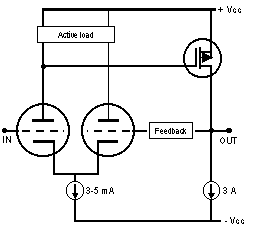![]()


![]()
![]()
![]()
Introduction
The HYBRID amplifier is a two-stage, DC coupled, single-ended, Class-A amp, capable to deliver around 30W in an 8ohms load or 15W in a 4ohms load. The output power can be easily increased by paralleling more output Mosfet devices and its associated current source. Parallel devices will contribute to increase the damping factor and lower the dependence from the load impedance. A stereo amplifier with two outputs Mosfet devices per channel will provide more than 50+50W of pure Class-A usable power to 6-8 ohms loads. Due to its Class-A operation, in such conditions the stereo amplifier will dissipate more than 300W, therefore appropriate heat sinks (at least with a thermal resistance of 0.2°C/W) and a suitable well-ventilated enclosure must be used.
Brief History
Attracted by the fashion and warm sound of old tubes and the technology advances in today's power Mosfet devices, I decided to build an hybrid single-ended, class A power amplifier that mix the best of both worlds.
For many years, power amplifiers used only vacuum tubes, and today's modern amplifiers almost use transistors. Tube amplifiers operate on the same principles as transistor amplifiers, however the internal construction may be considerably different. Generally tubes are devices that operate at high voltage and supply low current. Instead, transistors are the opposite, they operates at low voltage and can supply high current. Tube amplifiers tend to dissipate a lot of energy in form of heat and in general are not very efficient. One of the most relevant differences between a tube and a transistor amplifier is the use of an output transformer. Because of the high output impedance of a tube circuit, an output transformer is in general required to properly deliver power to a loudspeaker. High quality audio output transformers are difficult to design, and tends to be large, heavy, and expensive. A transistor amplifier does not require output transformers, and tend to be more efficient, smaller, and do not require periodic replacement.
Many people believe that tube amplifiers can have excellent sound and claim that tube amplifiers have their own particular sound. What is sure is that there are sonic differences between tubes and transistors amplifiers.
Sincerely, I appreciate both worlds and I have had the opportunity to hear wonderful sounding systems using both technologies.
Combined tubes and Mosfet operation
The intention when designing the HYBRID amplifier was to exploit the opportunity to combine the best attributes of both tubes and transistors technologies. Tubes offer full and faithful sound reproduction, rich detail, brilliant clarity and accurate tracking of complex waveforms. Tubes are better at doing deep bass and extended sweet and natural highs. Transistors are able to drive even difficult speakers while providing authoritative bass performance.
In the HYBRID amplifier, the magical midrange, soundstage size, air and overall musicality from a tube input stage passes directly to a low distortion solid state output stage that retains a great measure of the good tube qualities in its output and provide a better interface to modern loudspeakers.
T

The HYBRID simplified circuit diagram